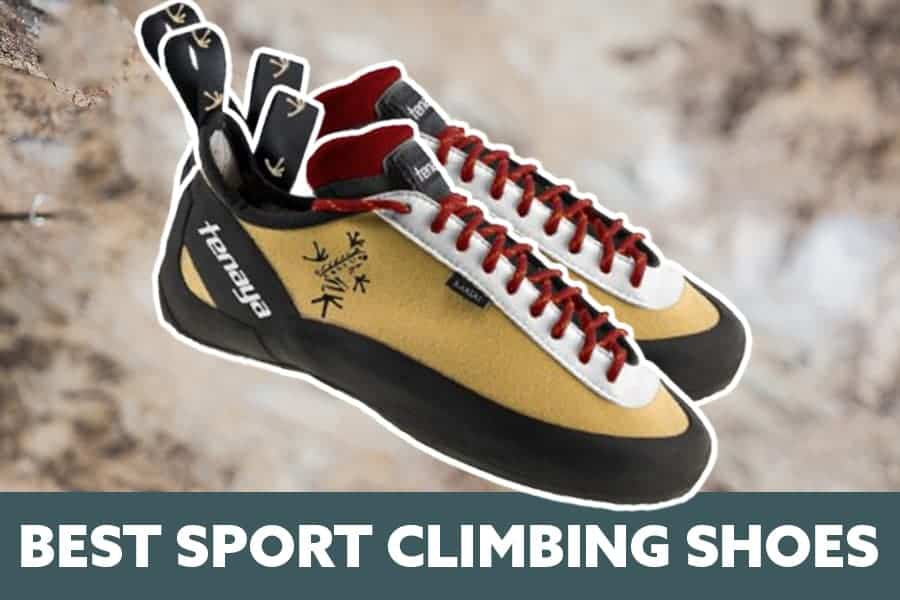I usually boulder more than I sport climb but lately, I’ve been wanting to get more serious with sport climbing so I decided to get a pair of climbing shoes that are specific for sport climbing.
To narrow down what shoes to purchase, I did some research.
Finding the best shoe for sports climbing can be difficult because there are so many climbing shoes available. At REI (one of the biggest outdoor recreation stores in the USA), there are 109 climbing shoes available to purchase for adults from eight different brands.
What should you look for in sport climbing shoes? For the best sport climbing experience, your climbing shoes should have a stiff midsole, be good for edging, have a nice fit in the heel cup and ideally a lace closure. A shoe with a moderate downturn will make it easier to scale any type of climb.
After hours of research through articles, videos and online reviews, I found that the Tenaya Masai Climbing Shoes( See price from Backcountry) has all the features I need at a decent price.
As a top alternative, I’d also consider the La Sportiva Katana Lace-ups (Link to product on REI). They meet all the requirements I recommend for sport climbing. Unfortunately for me, they don’t fit the shape of my feet.
If you want to get the most value out of your shoes, it is a good idea to nail down what you like or need with your climbing shoes and then find a shoe that has those qualities at a good price.
Everyone may need something slightly different, but there are some general guidelines and recommendations to help you find the right shoes for you.
What To Look For In Sport Climbing Shoes
When it comes to finding the right shoe for your sport climbing adventures, there are many things that you should consider. Here is what most professional climbers and coaches recommend reviewing before making your purchase.
Climbing Shoe Shape – Moderate vs. Aggressive and Flat
One of the fastest and easiest ways to narrow down your shoe options is to look at the shoe shape that you want to get for sport climbing shoes. There are three shoe shapes in climbing shoes, aggressive, flat and moderate. For most climbers, moderate climbing shoes are going to be the best option.
Aggressive Shoes:
A lot of climbers think that when they are leveling up in their climbing, that they need to get an aggressive shaped shoe. However, aggressive shoes aren’t ideal for most sport climbing routes.
Aggressive shoes are difficult to smear with and the shape they force your feet into makes it so that your feet get tired faster. Since sport routes are usually over 20 meters tall, you will be wearing them for a longer period of time and you need to be relatively comfortable in your shoes.
Flat Shoes:
In comparison, the flat shape shoe is good for staying comfortable for long periods of time, which is important for sport climbing, especially for beginner climbers. However, flat shoes don’t have as much toe support so it may be more difficult to hold your feet on the wall when you are climbing slightly inverted.
Moderate Shoes:
A nice middle ground between aggressive and flat shaped shoes is a moderate downturn. Moderate shoes make it so that you can climb long distances without getting foot pain or too tired from wearing the shoes but it still has the versatility to do overhangs or other movements that may require a curved foot shape or smears when a more flat profile is needed.
Tenaya Masai Climbing Shoe Shape: Moderate
The Tenaya Masai climbing shoes have a moderate downturn so they are a good middle ground shoe that will allow you to smear when smearing is needed and hold onto footholds while in overhang climbing as well.
In addition, many climbers have reported that their feet feel more comfortable in these shoes compared to some other moderate shoes because of the way they hold your foot in a moderate downturn.
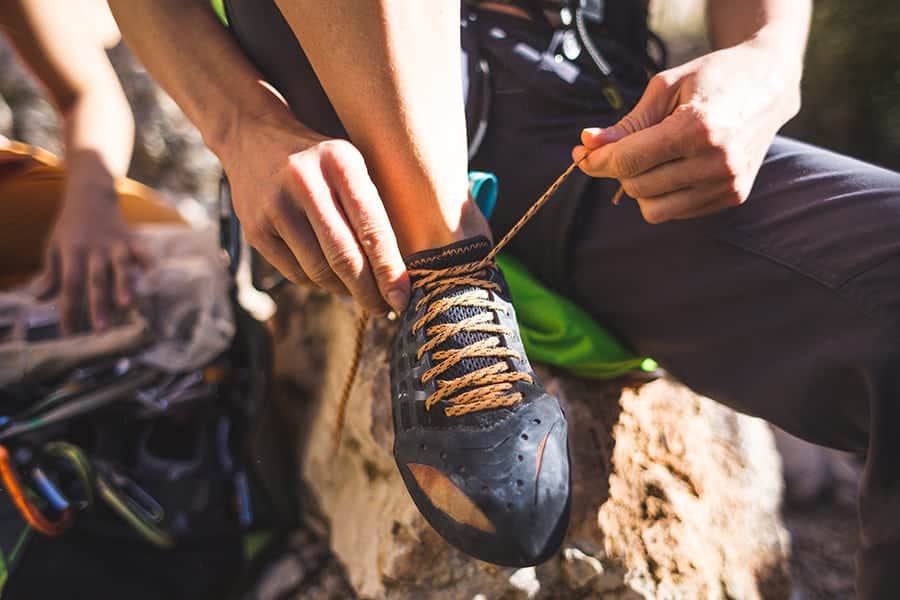
Climbing Shoe Closure – Laces vs Straps
The way a climbing shoe closes is either with laces or some sort of velcro strap. In the case of sport climbing, most climbers prefer shoes that lace up. Laces allow you to adjust the tightness of every part of your shoe so it can fit snug to your foot, no matter the shape of your foot.
Being able to customize the shoe to your foot shape does three main things –
- Laces make it so that your shoe is snug and comfortable. When the shoe conforms to the shape of your foot, you are less likely to get blisters or hot spots. Because of this, climbers that wear laced shoes usually can wear a more comfortable size compared to those that have velcro closure systems because they can customize the shoe size to the width of each part of their foot better.
- It makes it so that you can edge easier and feel the rock under your foot better. Some of the sensitivity and edging aspects of your shoe is based on the rubber and how thick it is. However, if your shoe fits tight in someplace and loose in other, the loose places will have a harder time being utilized for edging and it will be harder to feel the rock in that area of your foot. Laces allow you to adjust space in different parts of the shoe to ensure it is tight everywhere.
- A tight and conformed fit can make heel and toe hooks easier and more comfortable. If your entire foot is conformed to, then the shoe is likely to move. In comparison, if the shoe has spaces where it is wider or doesn’t fit as snug, you will likely have slipping issues in that area.
That being said, I still wouldn’t rule out velcro shoes completely. Depending on your foot shape, some velcro shoes will work great. A nice thing about velcro shoes is how easy they usually are to take on and off, which is nice for sport climbing indoors.
Tenaya Masai Climbing Shoe Closure: Laces
The Masai climbing shoes have laces that go from the toe all the way to the heel so you can adjust the fit around every part of your foot to make sure it is snug and comfortable.
The laces on the Tenaya Masai are easy to adjust and are high quality so it is unlikely for them to break or need to be replaced. Though, if you climb in a lot of dirt, it may be a good idea to wash the shoelaces (you can wash laces in the wash).
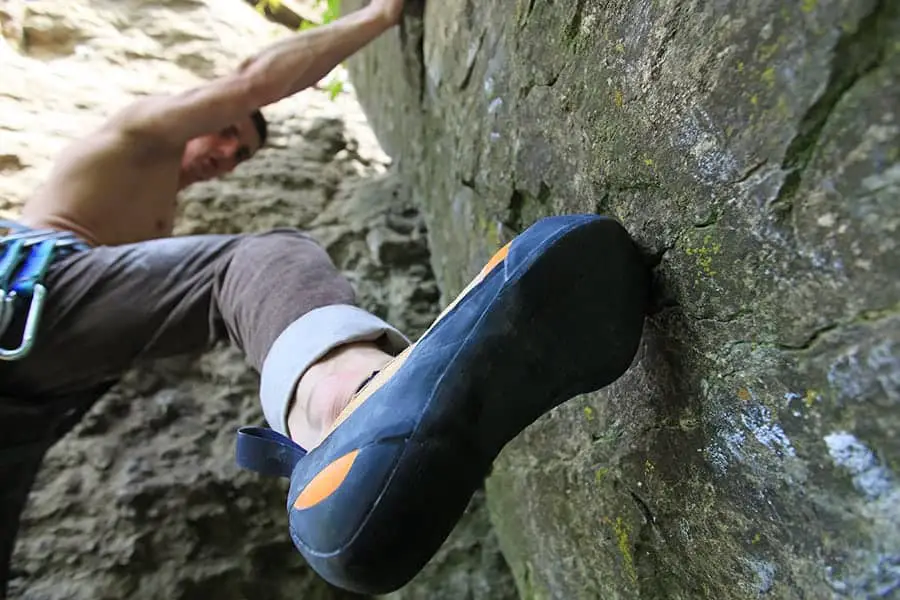
Rubber – How To Evaluate The Rubber on Climbing Shoes
Unlike the shape of the shoe or the closure system, however, there isn’t a filter on a website that lets you choose the rubber that you prefer. This is because every brand has its own patented rubber so you can’t easily compare across brands.
Instead, you have to look at the thickness, tackiness and flexibility of the rubber on a climbing shoe. It isn’t always possible to do this from the comfort of the internet, so going to the store and actually feeling the rubber or going to a shoe demo is a great way to get acquainted with what kind of rubber you like the most.
In my case, I compared personal experiences with the rubber along with common reviews of each shoe, since the rubber is a “hot topic” when it comes to shoe reviews.
Thickness:
When the rubber is thick, you usually have more stability and support to help hold your feet up. However, thicker rubber also means that you won’t be able to feel the rock beneath you. Being able to feel the dime under your toe can be important for many climbers when it comes to confidence in weight placement as well as confidence in foot placement.
Tackiness/Stickiness:
The tackiness or the stickiness of your shoe’s rubber also makes a difference because some rubber (cheaper rubber) isn’t very sticky so you won’t be able to grip the rock or plastic as well as if you had a better quality rubber.
Unfortunately, it is difficult to compare shoe rubber between brands because every brand calls their rubber something different. It could be the exact same rubber and we’d never know.
Part of the stickiness of your shoe rubber is also based on the texture that the shoes have on them. Most climbing shoes have a flat profile with a small scratch-like or brush-like texture that helps give extra friction between your shoes and the rock.
Flexibility:
There are both pros and cons to how flexible the rubber is. One benefit is that flexible rubber usually conforms to your foot better and thus creates a better fit. However, flexible rubber also makes it so that there isn’t as much support on your foot.
The better the foot support, usually the longer you can climb without your feet getting tired.
Tenaya Masai Climbing Shoe Rubber:
I discovered is that the Tenaya Masai Climbing Shoe provides a great balance between thickness and stickiness with a Vibram XS Grip 4 mm rubber sole.
Many climbers have reported that they like how the shoe has continued to stay sticky for a long time despite how much use they get on sandstone, limestone or granite in comparison to most other rubber.
This is an important consideration because I’ve gone through many shoes that are sticky for the first 25 climbing sessions and then they seem to lose the tackiness and have to get resoled or treated or replaced sooner than I’d prefer.
Upper and Lining Material: Leather vs Synthetic
What the shoe is made out of in the uppers is usually more of a preference in comparison to a performance issue. There are pros and cons of both leather and synthetic uppers (the most common materials used to make uppers).
For example, leather can stretch up-to an entire size bigger so climbers often get a size smaller so that they fit well when they stretch. This is both a pro and a con. It is a pro because the fit of your shoes after they stretch to fit your feet is usually really custom to your foot shape. However, it is a con because until they stretch to fit your feet, you will likely be in a shoe that is a size too small so there is a period of time that you may feel extremely uncomfortable in your shoes.
Here are some quick bullet-points for each of the most common upper materials.
Leather:
- Leather (unlined) will stretch over time so climbers often get a size smaller to compensate for when they stretch.
- Leather usually doesn’t stink as much as synthetic material
- Leather can be more difficult to clean compared to synthetic but it usually stays cleaner longer than synthetic
- Leather is made from animals so some climbers prefer not to wear it
Synthetic:
- Synthetic uppers usually hold their shape better so you don’t have to worry about stretching them out.
- Synthetic shoes are known for holding odors more than leather so they are more likely to stink
- Some synthetic shoe materials breath and/or wick away sweat better than leather
- Synthetic is made with inorganic materials so some climbers prefer wearing it over something made from animals, especially vegetarians and vegans
For me, this feature doesn’t matter very much as I’m not a vegetarian or vegan.
I’m fine getting a size smaller if it is leather and dealing with breaking into them before they stretch. Plus I get really sweaty feet when I climb so the break-in time is faster. Finally a perk for sweaty feet!
In addition, I always spray my shoes with Lysol after every climbing session so I also don’t have to worry about how it smells either. Not a perk of climbers with sweaty feet…
The Tenaya Masai Climbing Shoe Material: Microfiber and Cotton Lining
The Tenaya Masai shoe is made with microfiber and TXT treated cotton lining so they don’t stretch. This means that the shape of the shoe won’t be as custom to my foot as it would be with leather but they fit really well (see below) so I’m not worried about that.
Some climbers claim that the Tenaya Masai shoes are vegan and vegetarian friendly, but since we don’t know what makes the microfiber, I’m not confident in saying that. Plus, some say that sheering sheep for the cotton isn’t something to be ok with, so it depends on where you land on the spectrum of animal rights, etc.
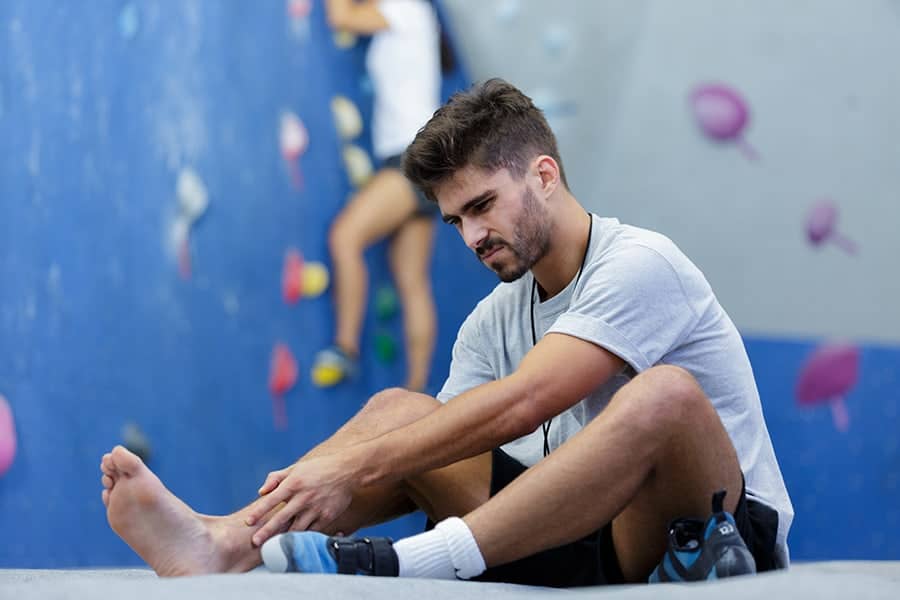
Climbing Shoe Fit: Length and Width
The nice thing about shoe sizes is that you can usually find one in any brand or shoe type that fits the length of your foot. However, when it comes to finding the next best shoe for you, you should also consider the width of your feet.
This is probably the most important part of a climbing shoe and is one of the reasons that different people prefer different types of shoes and shoe brands. Every shoe model and brand usually has a different width.
The width of your climbing shoe can affect many parts of the shoe fit:
- How snug the heel cup fits
- How snug your toe knuckles fit
- How much lateral space your foot has in the shoe
Some people have really wide heels and thus they fit better in shoes that have a lot of space for the heel. In comparison, if you have a small heel or super-wide toe knuckles, then a different type of climbing shoe will fit your foot best.
The most common way for a brand to differentiate on this spectrum is by assigning a gender to the shoe. Women’s shoes are generally more narrow than men’s shoes and unisex shoes are often in the middle of the two.
Another way that is becoming more common for climbers and climbing shoe brands to indicate where they are on the spectrum is by indicating if it is high-volume or low-volume. The high-volume shoes are wider than the low-volume shoes.
The Tenaya Masai Climbing Shoe Fit:
In street shoes, I fit an 8.5-9 women size shoe and I fit well in the 8.5 Tenaya Masai climbing shoes so the sizing is similar to street shoes. Tenaya created a fitting table PDF, which I’ve uploaded here, for your reference.
In addition, I tend to fit better in shoes that are for average to narrow feet. With that being the case, I love how these shoes fit my heel and toes. There isn’t any movement in my heel and my toes don’t get painfully cramped.
This makes it so that it is small enough that I feel the support I need for edging, heel hooks and toe hooks without the pain. When I take them off, I notice that I was wearing climbing shoes so they are a little tired, but I feel like I could trad climb or big wall climb in these as well without any issues.
Price of Climbing Shoes
To get the most value for your money, the price is very important. Climbing shoes can be often be judged based on their price because brands save the best rubber, the best uppers and the best support for their top-priced products.
However, different shoes with the same quality rubber, uppers and support have different prices because of the brand sewn into the shoe.
The Tenaya Masai Climbing Shoe Cost:
I’ve seen these shoes range from $112 on sale up to $150 depending on where you purchase it and if it is on sale. At the making of this article, the best price I could find from a reputable retailer is at BackCountry.
Weight
I consider weight more of a tie-breaker and not a deciding factor when it comes to choosing your shoes because most climbing shoes are within a couple of ounces from each other and I haven’t been in such a competitive space that an ounce or two actually makes a difference on my climbing experience or performance.
However, the weight of a shoe can make a difference if you are climbing long routes or your feet get tired quickly. If the weight of your shoe is heavier, then it takes more work to pull it up the wall compared to a lighter shoe.
With that being said, here is a breakdown of the top shoes recommended by climbers for Sport Climbing:
| Tenaya Masai | 6 oz |
| Scarpa Instinct VS | 7.1 oz |
| La Sportiva Otaki | 7.7 oz |
| Five Ten Anasazi Lace | 8.7 oz |
| La Sportiva TC Pro | 8.71 oz |
| La Sportiva Katana Lace | 8.71 oz |
| Scarpa Maestro Mid Eco | 9.7 oz |
| Madrock Phoenix | Not Published |
The Tenaya Masai Climbing Shoe Weight:
As you can see, the Tenaya Masai climbing shoes actually come in lighter than the other top recommended shoes. Again, however, this is not a deciding factor for me since I haven’t gotten to the level of climbing where one or two ounces actually makes a difference in my performance.
Top Alternatives
There are A LOT of great climbing shoes specific for sport climbing so here are the top alternatives that are highly recommended by climbers but didn’t quite make the cut for me.
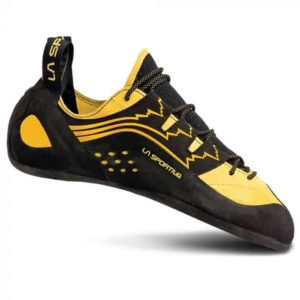
La Sportiva Katana Lace
See price from REI here.
If it weren’t for the fit of my heel in these shoes paired with the price, these would be my top alternative shoes. The Katana Lace shoes were probably the most popular recommendation next to the Anasazi lace-up shoes.
Many climbers rave about how comfortable the shoes are, even if you size a couple down from your normal climbing shoe size.
Based on the main features, they meet the requirements of great sport climbing shoes, but as I mentioned, they don’t fit my heel well so I’m not going to purchase these for myself. Though, they may fit other climbers’ feet well, which would make the price worth it.
- Shape: Moderate
- Rubber: Vibram XS Edge (4mm)
- Closure System: Laces
- Material: Leather and Synthetic Leather
- Fit: These shoes are Unisex so they are supposed to be an average width.
- Weight: 8.71 Ounces – average/heavy for most sport climbing shoes
Sized appropriately, the Katana can jam up a finger crack, smear up a slab, or edge through an overhung sport climb. It styles a permanent moderate downturn—thanks to La Sportiva’s P3 technology—and lower asymmetry for a balance between high performance and a comfier feel. Vibram’s XS Edge rubber has a harder compound than Vibram’s Grip, and it ensures long-lasting traction suitable for granite slabs, sandstone smears, and limestone edging.
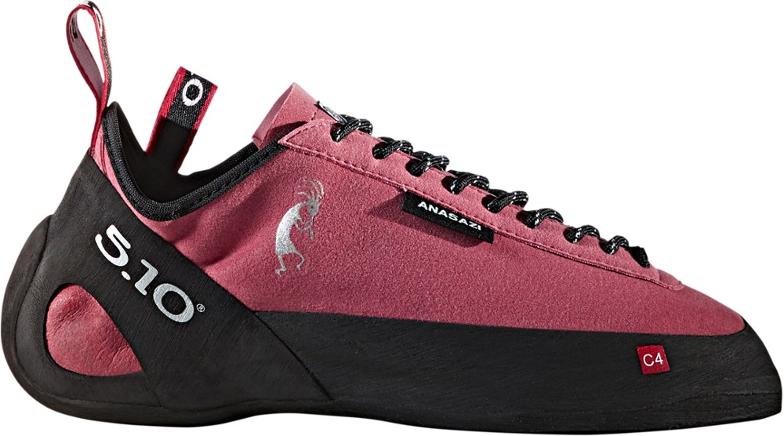
Five Ten Anasazi Lace
See price from REI here.
This is my top alternative recommendation because everyone seems to LOVE these shoes for sport climbing.
They have been known to have great rubber so you feel sticky on climbs and the rubber is firm enough that you don’t have to worry about your performance being compromised by comfortably fitting climbing shoes.
For me, my feet don’t fit as well as they do in the Masai shoes so it was an easy choice between the two (fit is everything!)., However, they may fit your feet perfectly so it’s worth checking out.
- Shape: Moderate
- Rubber: Stealth C4 rubber
- Closure System: Laces
- Material: Polyester and Synthetic
- Fit: These shoes are Unisex so they are supposed to be an average width.
- Weight: 8.7 Ounces – average for most sport climbing shoes
Five Ten updated this Anasazi with a stiff midsole, moderate asymmetry, and Stealth’s best-selling C4 rubber sole to give it the best edging performance in Five Ten’s collection.
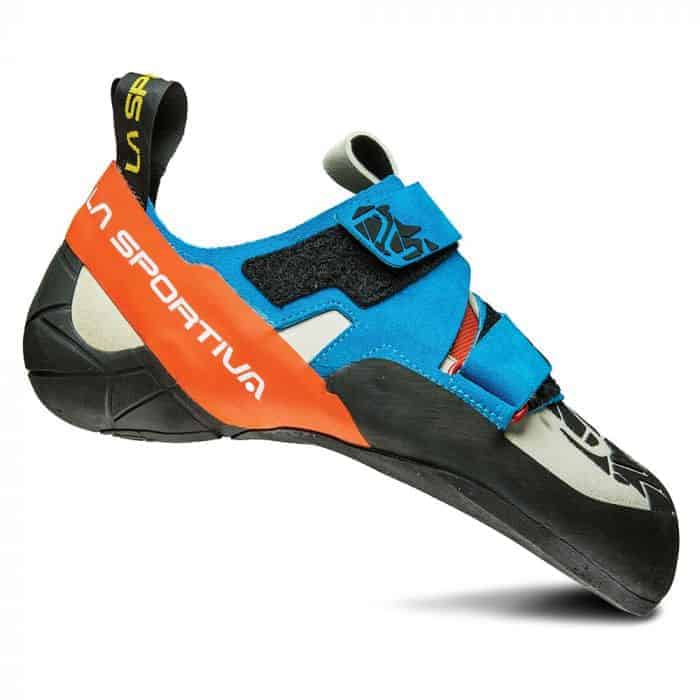
La Sportiva Otaki
See the price from REI here.
If you were going to have one shoe for bouldering and sport climbing and you are experienced enough that aggressive shoes won’t kill your feet on long routes, then this would probably be a great shoe purchase.
The Otaki climbing shoes are noted as one of the most versatile climbing shoes in the La Sportiva lineup. Climbers are loving these shoes for sport climbing, trad climbing and even a little bouldering and saying that they are super comfortable while giving them the extra technical advantage that they need in their climbing performance.
I didn’t choose these shoes because they are aggressive, which isn’t the best for sport climbing, and pair that with velcro straps and a hefty price tag, they don’t fit my requirements for sport climbing shoes and therefore aren’t the best choice for me.
- Shape: Aggressive
- Rubber: Vibram XS Edge (4mm)
- Closure System: Velcro Straps
- Material: Leather and Microfiber
- Fit: These shoes are Unisex so they are supposed to be an average width.
- Weight: 7.7 Ounces – average for most sport climbing shoes
P3 technology applies a Permanent Power Platform that ensures the Otaki’s downturn stays downturned. The S-Heel construction optimizes heel hooking and gives a snug fit, while Vibram’s XS Edge sole sharpens the sides for ideal edging, slicing, and dicing.
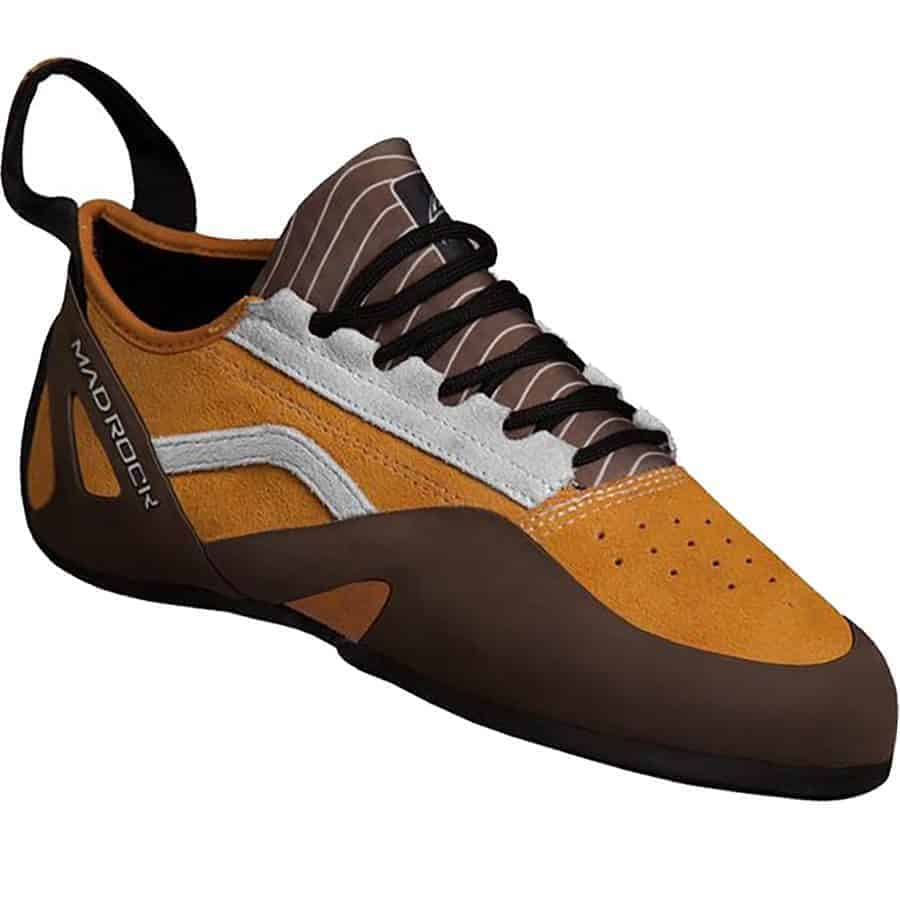
Madrock Phoenix Climbing Shoe
See the price from Backcountry here.
The value you get for the price of this shoe makes it impossible for me not to mention. The Phoenix is remarkably stiff for solid support, and Science Friction 3.0 rubber ensures traction on plastic as well as rock.
I love Madrock’s Science Friction 3.0 rubber as it is the same rubber that is in my favorite bouldering shoe, so if you are looking for a cheaper shoe (probably the cheapest with laces) than this is a great shoe to try.
- Shape: Moderate
- Rubber: Science Friction 3.0 rubber
- Closure System: Lace
- Material: Leather
- Fit: These shoes are Unisex so they are supposed to be an average width.
- Weight: I can’t find this detail anywhere online and I don’t plan on bringing a scale with me to the store to find out for you… sorry.
Many climbers that have tried these shoes are blown away with the value you get at such a low price. It is a great shoe for beginners that are just getting into the sport as it has great support above and below your shoe. It is especially good for long routes as it’s been known to be very comfortable (common for Madrock shoes).
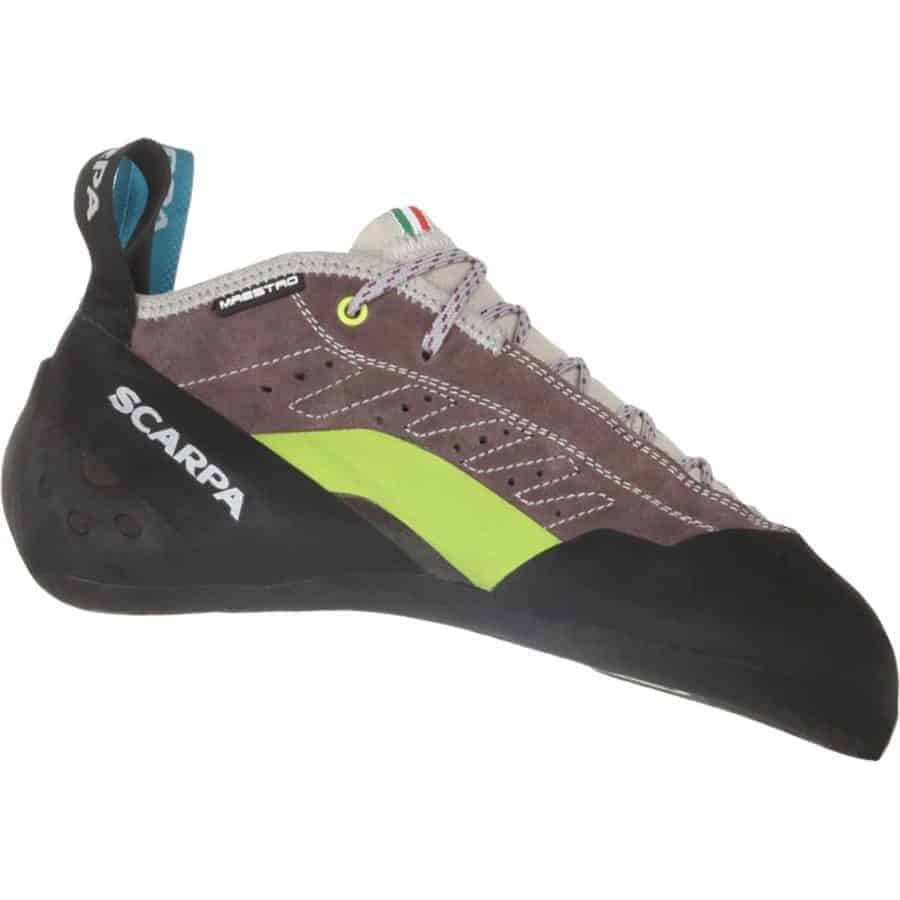
Scarpa Maestro Mid Eco Climbing Shoes
See the price from REI here.
The Scarpa Maestro Mid Eco climbing shoe was built with trad climbing in mind, but it is also great for sport climbing.
Many climbers recommend it for sport climbing because it has great rubber and apparently it is comparable to the La Sportiva TC Pro, which gives you additional protection when jamming your feet into cracks.
However, it has a flat shape and is heavier than most sport climbing shoes so pair that with the price – it is more worth mentioning than recommending.
- Shape: Flat
- Rubber: Vibram® XS Edge
- Closure System: Lace
- Material: 2.0mm Eco Leather
- Fit: These shoes come in men’s (wider) and women’s sizes (narrower)
- Weight: 9.7 oz – heavier than most sport climbing shoes
The Scarpa Maestro Mid Eco climbing shoes are a trad shoe that is anything but traditional, the Maestro Mid brings comfort to uncomfortable situations. The supportive IPC-Tension™ active rand, innovative Eco-leather patterning, and protection where you need it, combine to offer versatility across a wide range of classic climbs.
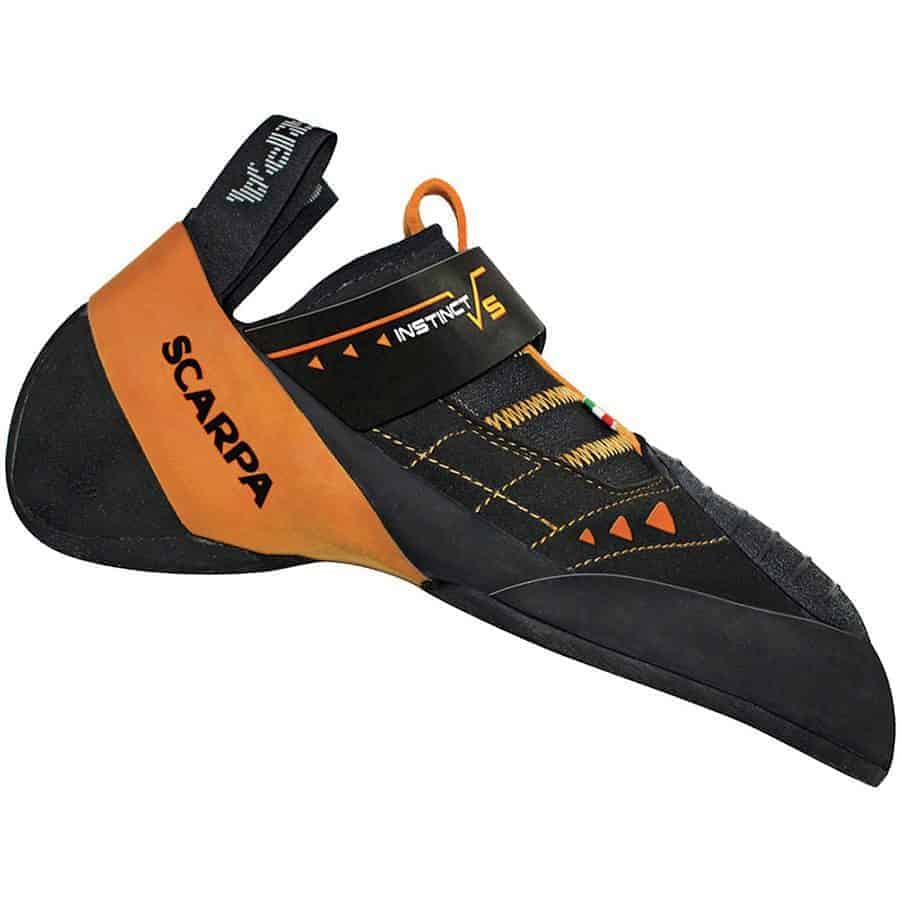
Scarpa Instinct VS
See the price from REI here.
The Instinct VS are probably more of a bouldering shoe than it is a sport climbing shoe. It has many of the qualities I’m looking for in a sport climbing shoe, but it uses a velcro strap and has a hefty price tag.
It deserves a highlight here because it is an amazing shoe and most climbers that have used this shoe report that it is amazing.
- Shape: Moderate to Aggressive
- Rubber: XS Edge rubber grips rock and endures regular wear
- Closure System: Velcro Straps
- Material: Microsuede
- Fit: These shoes come in men’s (orange) that are wider than the women’s (blue) sizes that are narrower.
- Weight: 7.1 Ounces – competitive with most climbing shoes
Many climbers highly recommend this shoe for bouldering and surprising a lot recommend it for sport climbing as well.
It is a Winner of Climbing Magazine’s Best in Class award, however, coming from a Public Relations background, I know that most awards aren’t very fair to judge a product or business on because the business usually pays a certain amount to enter in for the running. This makes it so that other notable brands may not decide to spend their PR or marketing budget on that award and thus they aren’t in the running for the award so the shoe that pays to get in the running may or may not be the best, they are just the best out of the selection that decided to pay.
Despite that concern, the Scarpa Instinct VS Climbing Shoe is designed for performance. With its curved, asymmetrical last and softer construction, this all-around shoe handles a variety of styles. Its rubber toe patch provides maximum toe hooking power while the thin sole delivers enhanced flexibility and sensitivity so you can confidently take on more challenging projects.

